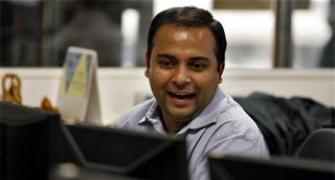 The longest winning streak was the six years between 2002-2007 when the Nifty moved from around 1,000 to over 6,000, says Devangshu Datta.
The longest winning streak was the six years between 2002-2007 when the Nifty moved from around 1,000 to over 6,000, says Devangshu Datta.
The major market indices such as the Sensex and Nifty are both up by about 33 per cent in the first 10 months of this calendar year. Mid-caps and small-caps have gained even more. There is no apparent reason for the rally to come to an end.
So, it is quite possible that 2014 will end with even larger gains. This is the third calendar year in a row that the market has seen net gains, assuming no huge crash occurs in the two remaining months.
In fact, there have been net gains in 11 years of the 15-year period from 2000 to 2014. The longest winning streak was the six years between 2002-2007 (both years inclusive) when the Nifty moved from around 1,000 to over 6,000.
The last losses came in 2011 when the Nifty/Sensex fell by around 25 per cent. Prior to that, the market fell by about 50 per cent in 2008. It also fell by 16 per cent in 2001 and by 15 per cent in 2000.
The movement of the stock market is influenced by many things. For example, GDP growth rates and trends have some influence. So do corporate earnings trends, money supply, interest rates, inflation and forex rates. Global growth conditions and liquidity also have correlations with stock markets.
The textbook says it is possible to figure out what factors have high correlation by running a multiple regression. A multi-regression would tell us in theory if there were strong relationships between any or all of the above variables and the stock market.
Unfortunately, a "multi" doesn't tell us a great deal new in this particular case. There are far too many factors involved. Also, it's a long period. All the variables mentioned above have significant correlation (or inverse correlation) with the Nifty. Many have correlations with each other as well. The Indian economy went through enormous changes between 2000 and 2014. For that matter, the global economy also saw huge changes.
However, while rigorous regression analysis is difficult, some observations can be made. The stock market return does correlate very closely to GDP trends, at least in terms of GDP as measured in India. India measures GDP as growth exceeding Wholesale Price Index (WPI) inflation.
In those terms, GDP grew year-on-year every year through 2000-2014 though there were periods of slowdown. But the market did not go up every year. Nor did it slow down in coincidence with GDP growth slowdowns.
However, GDP may not have grown every year in dollar terms, given currency depreciation. For example, GDP did shrink in dollar terms in 2013, while the Nifty rose by 7 per cent. Also, GDP may not have grown every year if measured against retail inflation as indicated by the consumer price indices.
There were times when CPI was clearly running much higher than WPI. There is often a 3-4 per cent spread between the two. Unfortunately, reliable CPI data don't exist.
Index returns and earnings growth also don't correlate as tightly as one would hope. There are periods (like the fiscal 2013-14) when EPS growth was slow but the market gained a lot. Conversely, there are periods (such as the Q4, 2007-8 and the first half of 2008-9) when EPS grew strongly but the market lost a lot of ground. This lack of correlations to earnings is certainly due to the well-known fact that investors always base decisions on future expectations rather than current earnings.
Strong correlations seem to exist between FII attitude and stock market movements. This is easy to explain because FIIs have much deeper pockets than domestic investors and generally contribute a larger fraction of trading volumes. Since FII attitude is heavily influenced by global liquidity, and in turn, FII attitude impacts forex rates, those correlations are also marked.
GDP data and earnings records have lead-lag relationships with stock prices. FII attitude directly influences stock prices without any lags. So it is a much more immediate impact. If there is one single variable that a short-term trader should track and analyse, it is probably FII attitude.
Unfortunately, FII attitude is not easy to pick up in real time. The analyst needs to work through data and leads from multiple sources such as institutional research reports, public statements, global allocations, prior track records, etc.
There is some degree of predictability to FII allocations but it's not easy to decipher the patterns. However, the rewards for working out FII predictability and narrowing down into their areas of interest is very high. There are some clues in the data and a focus on this could yield terrific returns.










